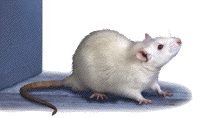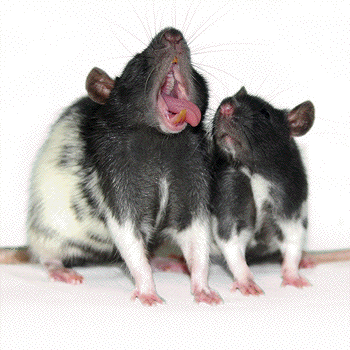- Repeated episodes of yawning and penile
erection can be induced in rats and other
experimental animals by the systemic
administration of low doses of dopamine (DA)
agonists, such as apomorphine, by the central
administration of adrenocorticotropin (ACTH),
alpha-melanocyte-stimulating hormone (a-MSH) and
related peptides, and by the
intracerebroventricular (i.cv.) injection of
oxytocin. While the importance of penile
erection in reproduction does not need to be
further stressed, it is pertinent to recall
that yawning, alone or associated with
stretching, is considered to be an ancestral
vestige surviving throughout evolution, that
subserves the purpose of arousal.
-
- ORIGINE : Souche
sélectionnée pour une
fréquence élevée de
bâillements = HY (High Yawning)
sous-souches LY (Low yanning)
-
- GENETIQUE
- - Génération F21 pour HY et
F16 pour LY en 1989. Caractère LY
partiellement dominant sur HY (URBA-HOLMGREN
1990)
- - Génération F23 pour MY, F21
pour LY en 1992 (URBA-HOLMGREN 1993)
-
- COMPORTEMENT
- - Fréquence de bâillements de
21,5/heure pour les males HY
- 1,95/heure pour les femelles HY
- 0,9/heure pour les mâles LY
- 0,5/heure pour les femelles LY
(URBA-HOLMGREN 1990)
-
- - Le toilettage induit par la
nouveauté est plus important chez HY que
chez LY (MAYAHO 1995)
-
- REACTION AUX PRODUITS ET TRAITEMENTS
DIVERS
- - HY est plus sensible que LY à
l'augmentation des bâillements
provoqués par la physostigmine et
l'apomorphine. Les deux souches
réagissent de la même
manière à l'augmentation
provoquée par la pilocarine
(URBA-HOLMGREN 1993)
- - la pilocarpine inhibe le toilettage
provoqué par la nouveauté chez HY,
mais beaucoup moins chez LY (EGUIBAR 1997)
-

- BIBLIOGRAPHIE
- Eguibar JR
et Moyaho A Inhibition of grooming by
pilocarpirpine differs in high-and low yawning
sublines of Sprague-Dawley rats. Pharmacoology
Biochemistry and Bebavior 1997; 58: 2
317-322
- Moyaho A et
al Induced grooming transitions and open
field behaviour differ in high and low-yavning
sublines of Sprague-Dawley rats. Anim Behav
1995; 50 ; 61-72
- Urba-Holmgren R,
Trucios N, Holmgren B, Eguibar JR, Gavito A,
Cruz G, Santos A Genotypic dependency of
spontaneous yawning frequency in the rat Behav
Brain Res 1990 Oct 30;40(1):29-35
- Urba-Holmgren
R, Santos A, Holmgren B, Eguibar JR Two
inbred rat sublines that differ in spontaneous
yawning behavior also differ in their responses
to cholinergic and dopaminergic drugs Behav
Brain Res 1993 Sep 30;56(2):155-9
- Urba-Holmgren
R, Holmgren B, Rodriguez R, Gonzalez RM
Serotonergic modulation of yawning Pharmacol
Biochem Behav 1979 Sep;11(3):371-2
- Urba-Holmgren
R, Gonzalez RM, Holmgren B Is yawning a
cholinergic response? Nature 1977 May 19 267
(5608): 261-2 et commentaires Cholinergic link
in yawning A Cowan Nature 12/01/78 271
p187-188
- Urba-Holmgren
R, Holmgren B, Leon BA, Ugarte A
Age-dependent changes in serotonergic modulation
of yawning in the rat. Pharmacol Biochem Behav
1992 Oct;43(2):483-6
- Yawning
and penile erection: central
dopamine-oxytocin-adrenocorticotropin
connection Argiolas A
- Gimenez-Llort
L, Canete T, Guitart-Masip M, Fernandez-Teruel
A, Tobena A. Two distinctive
apomorphine-induced phenotypes in the Roman
high- and low-avoidance rats. Physiol Behav.
2005;86(4):458-466.

|




